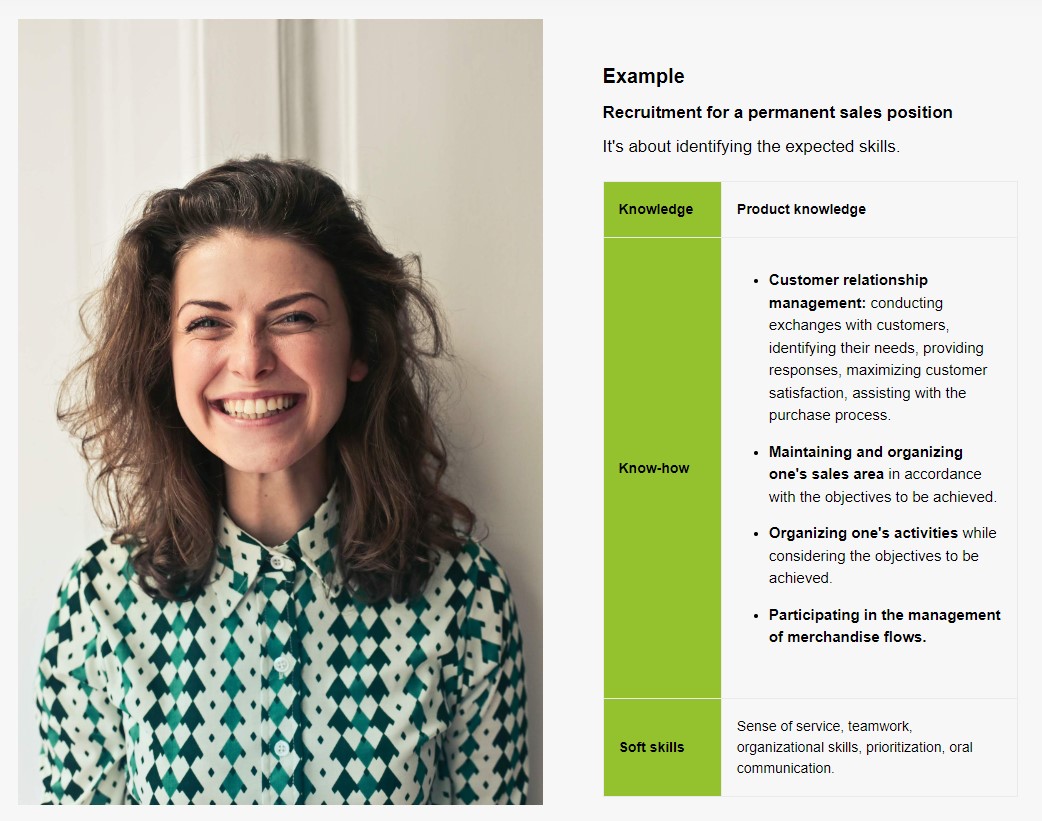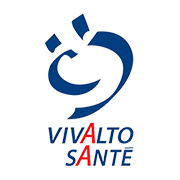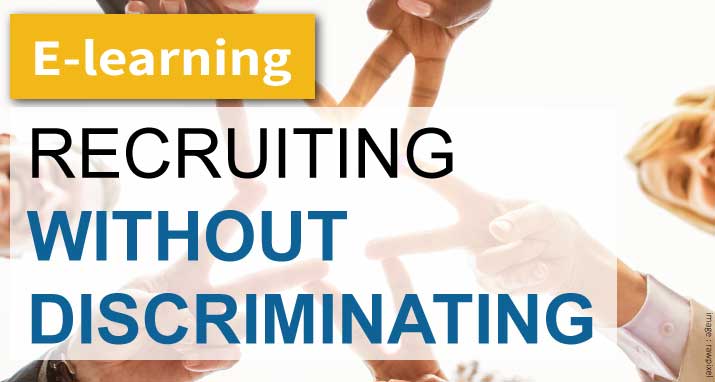

How to characterize discrimination in the workplace? What is the difference between direct and indirect discrimination? Can we recruit without discriminating? How to move towards a more inclusive process, from writing the job offer to the job interview and informing candidates?
Through quizzes and scenarios addressing "everyday" discrimination situations (disability, gender, place of residence, family situation...), the module equips you to consider singularities in the professional environment and offers best practices for recruiting without discrimination.



Contents
This E-learning is divided into three main parts.
The first part introduces the concepts of stereotype, prejudice, and decision-making biases, essential for understanding the phenomenon of discrimination in recruitment situations. The second part addresses the issue of discrimination from a regulatory perspective (prohibited criteria), emphasizing the subtleties between direct and indirect discrimination. Finally, the third part details best practices and reflexes to adopt for inclusive recruitment: reading CVs, job interviews, decision-making, and informing candidates.
- From stereotypes to prejudices
- Discrimination
- Towards a more inclusive recruitment process
Targeted skills
At the end of the training, you will be able to:
- Distinguish stereotypes, prejudices, and decision biases in recruitment situations.
- Understand the main issues of non-discrimination in the workplace.
- Be familiar with the legislation on the subject.
- Adopt the right behaviours in common situations.
Target audience
This training is intended for anyone involved in recruitment (HR, manager, etc.) and more generally for anyone interested in the subject of non-discrimination in the workplace.
Prérequis
No prior knowledge or skills are required to follow this training.

3 training chapters
Duration: 1 hour
Means and teaching methods: quizzes, animated slides, scenarios, and real cases
Certificate of completion
Access: Instant and guaranteed access for 1 year (renewable)
formationenligne@thconseil.fr | 04 78 57 94 23
Contents and Evaluation

From Stereotypes to Prejudices
- Stereotype, there you are!
- From prejudices to decision-making biases
- Chapter 1 quiz
Chapter Objective: to discern stereotypes, prejudices, and decision biases in recruitment situations.

Discrimination
- From prejudices to discrimination
- Prohibited criteria
- Direct and indirect discrimination
- Case studies
- And if I have a doubt
- Chapter 2 quiz
Chapter Objectives: to understand the main issues of non-discrimination in the workplace, to be familiar with the legislation on the subject.

Towards a More Inclusive Recruitment Process
- Reading resumes
- Job interview
- Decision and information of candidates
- Chapter 3 quiz
- Conclusion
Chapter Objective: to adopt the right behaviours in common situations.

Evaluation Methods in Relation to Objectives
Successful completion of the module is conditioned upon obtaining 75% correct answers on end-of-chapter quizzes (which can be retaken at will). It is necessary to pass all 3 end-of-chapter quizzes (total of 10 questions) and to go through all the content.
Objectives to Validate
- To discern stereotypes, prejudices, and decision biases in recruitment situations.
- Competency validated by activities and the Chapter 1 quiz (2 questions).
- To understand the main issues of non-discrimination in the workplace.
- Competency validated by activities and the Chapter 2 quiz (4 questions).
- To be familiar with the legislation on the subject.
- Competency validated by activities and the Chapter 2 quiz (4 questions).
- To adopt the right behaviours in common situations.
- Competency validated by activities and the Chapter 3 quiz (4 questions).
Certificate
Upon completion of the training and successful completion, a personalized success certificate (digital) can be downloaded from the platform.
Additional Indicators
- Accessible Content - The core of the course relies on text content, which is readable in order, and images with textual alternatives, as well as videos with subtitles.
- Overall Accessible Activities - Activities are accessible to different types of disabilities.
- Overall Accessible Learning Platform - The online learning platform hosted by TheMoocAgency is generally accessible, although the browsing experience may not always be optimal for some types of disabilities.
123 individuals partially or fully completed activities from the E-learning "Recruter sans discriminer", on the TH Conseil platform, from January 1 to December 31, 2024. For reasons of confidentiality and/or access to platforms not managed by TH Conseil, sessions of this module dedicated to clients are not included in this statistic. A significant portion of the accesses granted on the TH Conseil platform are tests allowing clients to assess the product before integrating it into their platform, which can significantly impact completion rates.
Completion Rate
91 learners out of 123 obtained the completion certificate (awarded when all quizzes and content have been validated), resulting in a 74% completion rate.
Satisfaction Rate
After completing the module, a questionnaire allows participants to evaluate the training based on several criteria and to provide recommendations in free text. The cumulative results as of January 1, 2025, based on 3 out of 9 criteria (for a total of 21 learners feedbacks since October 2022), are as follows:
*1 = "Strongly Disagree" 5 = "Strongly Agree"
Pricing
Contact us, and we'll take care of everything, including administrative follow-up.
Classic E-learning
- Access to the entire E-learning for 1 year
- Nominative success certificate
- Administrative follow-up (training agreement*, attendance certificate, reporting)
- Contact Us
Blended Learning
- Access to the entire E-learning for 1 year
- Nominative success certificate
- Administrative follow-up (training agreement*, attendance certificate, reporting)
- Half-day practical workshops in person
- Contact Us
*A training agreement will be established in the case of a minimum of 20 participants.
We inform you that this information is subject to computer processing intended to provide you with information on the services offered on the site and is intended for TH Conseil and its subcontractors. In accordance with the "Data Protection Act" of January 6, 1978, as amended in 2004, and the GDPR of 2018, you have the right to access and rectify information concerning you that you can exercise by following the procedures indicated in our privacy policy.
Integrate the E-learning "Recruiting without Discrimination" into your company's/organization's platform!

You already have an online training platform in your organization? Integrate our E-learning "Recruiting without Discrimination"!
- "Off-the-shelf" formula (integration of the module as is), or adaptable according to your needs (modified activities, added videos, adapted to your graphic charter, etc.)
- An internal rallying device: your teams can train at any time on disability in the workplace, without having to log in to an external platform
They have already opted for a customized online training by TH Conseil:


























































Why not you? To learn more, contact us at formationenligne@thconseil.fr or at 04 78 57 94 23.


